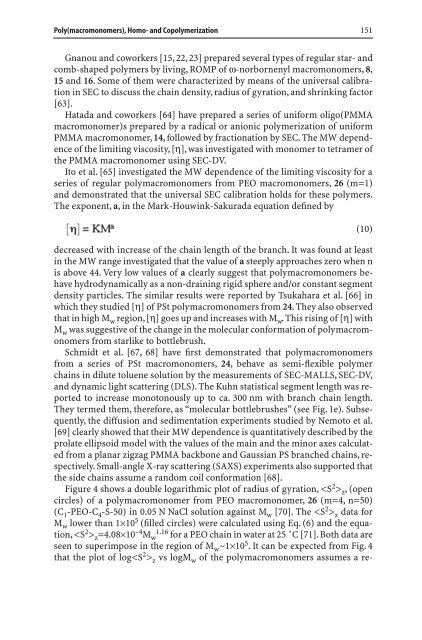142 Advances in Polymer Science Editorial Board: A. Abe. A.-C ...
142 Advances in Polymer Science Editorial Board: A. Abe. A.-C ...
142 Advances in Polymer Science Editorial Board: A. Abe. A.-C ...
You also want an ePaper? Increase the reach of your titles
YUMPU automatically turns print PDFs into web optimized ePapers that Google loves.
Poly(macromonomers), Homo- and Copolymerization 151<br />
Gnanou and coworkers [15, 22, 23] prepared several types of regular star- and<br />
comb-shaped polymers by liv<strong>in</strong>g, ROMP of w-norbornenyl macromonomers, 8,<br />
15 and 16. Some of them were characterized by means of the universal calibration<br />
<strong>in</strong> SEC to discuss the cha<strong>in</strong> density, radius of gyration, and shr<strong>in</strong>k<strong>in</strong>g factor<br />
[63].<br />
Hatada and coworkers [64] have prepared a series of uniform oligo(PMMA<br />
macromonomer)s prepared by a radical or anionic polymerization of uniform<br />
PMMA macromonomer, 14, followed by fractionation by SEC. The MW dependence<br />
of the limit<strong>in</strong>g viscosity, [h], was <strong>in</strong>vestigated with monomer to tetramer of<br />
the PMMA macromonomer us<strong>in</strong>g SEC-DV.<br />
Ito et al. [65] <strong>in</strong>vestigated the MW dependence of the limit<strong>in</strong>g viscosity for a<br />
series of regular polymacromonomers from PEO macromonomers, 26 (m=1)<br />
and demonstrated that the universal SEC calibration holds for these polymers.<br />
The exponent, a, <strong>in</strong> the Mark-Houw<strong>in</strong>k-Sakurada equation def<strong>in</strong>ed by<br />
(10)<br />
decreased with <strong>in</strong>crease of the cha<strong>in</strong> length of the branch. It was found at least<br />
<strong>in</strong> the MW range <strong>in</strong>vestigated that the value of a steeply approaches zero when n<br />
is above 44. Very low values of a clearly suggest that polymacromonomers behave<br />
hydrodynamically as a non-dra<strong>in</strong><strong>in</strong>g rigid sphere and/or constant segment<br />
density particles. The similar results were reported by Tsukahara et al. [66] <strong>in</strong><br />
which they studied [h] of PSt polymacromonomers from 24. They also observed<br />
that <strong>in</strong> high M w region, [h] goes up and <strong>in</strong>creases with M w. This ris<strong>in</strong>g of [h] with<br />
M w was suggestive of the change <strong>in</strong> the molecular conformation of polymacromonomers<br />
from starlike to bottlebrush.<br />
Schmidt et al. [67, 68] have first demonstrated that polymacromonomers<br />
from a series of PSt macromonomers, 24, behave as semi-flexible polymer<br />
cha<strong>in</strong>s <strong>in</strong> dilute toluene solution by the measurements of SEC-MALLS, SEC-DV,<br />
and dynamic light scatter<strong>in</strong>g (DLS). The Kuhn statistical segment length was reported<br />
to <strong>in</strong>crease monotonously up to ca. 300 nm with branch cha<strong>in</strong> length.<br />
They termed them, therefore, as “molecular bottlebrushes” (see Fig. 1e). Subsequently,<br />
the diffusion and sedimentation experiments studied by Nemoto et al.<br />
[69] clearly showed that their MW dependence is quantitatively described by the<br />
prolate ellipsoid model with the values of the ma<strong>in</strong> and the m<strong>in</strong>or axes calculated<br />
from a planar zigzag PMMA backbone and Gaussian PS branched cha<strong>in</strong>s, respectively.<br />
Small-angle X-ray scatter<strong>in</strong>g (SAXS) experiments also supported that<br />
the side cha<strong>in</strong>s assume a random coil conformation [68].<br />
Figure 4 shows a double logarithmic plot of radius of gyration, z , (open<br />
circles) of a polymacromonomer from PEO macromonomer, 26 (m=4, n=50)<br />
(C 1 -PEO-C 4 -S-50) <strong>in</strong> 0.05 N NaCl solution aga<strong>in</strong>st M w [70]. The z data for<br />
M w lower than 1´10 5 (filled circles) were calculated us<strong>in</strong>g Eq. (6) and the equation,<br />
z =4.08´10 –4 M w 1.16 for a PEO cha<strong>in</strong> <strong>in</strong> water at 25 ˚C [71]. Both data are<br />
seen to superimpose <strong>in</strong> the region of M w ~1´10 5 . It can be expected from Fig. 4<br />
that the plot of log z vs logM w of the polymacromonomers assumes a re-
















